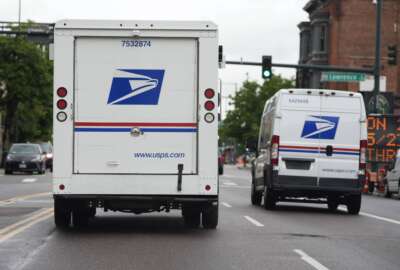The Postal Service delivered a greater percentage of mail-in ballots on time in the 2022 midterm elections than in other recent election cycles, well surpassing its performance targets.
USPS, however, may have lost out of tens of millions of dollars in additional revenue, as many states received a higher level of delivery service for ballots mailed to voters than they actually paid for.
“While the prioritization of Election Mail and implementation of key practices and extraordinary measures help ensure Election Mail is processed and delivered on time, they also impacted revenue and costs for the Postal Service,” the USPS Inspector General’s Office wrote in a recent report.
USPS delivered more than 103 million ballots between April and December 2022, and was able to measure service performance for nearly 80% of those ballots.
Of the ballots that USPS could track, USPS OIG found the agency delivered more than 97.3% of them on time.
The IG found that’s a higher rate of on-time delivery than in 2020 when USPS delivered 96.6% of ballots on time, and 2018, when it delivered 95.6% of ballots on time.
USPS can only measure service performance when ballots are sent full service and receive processing scans. The agency, however, expedited the delivery of some ballots — delivering them to election offices once received at USPS processing centers — and didn’t all the processing scans that all other pieces of mail would receive.
The IG’s office found USPS delivered more than 9 million first-class mail ballots in 2022 — a fraction of the more than 73 million ballots that went out as marketing mail.
USPS, as part of its longstanding election mail processes, treats all marked ballots as first-class mail — which is delivered within one-to-five days — even if state election offices paid a lower marketing mail rate, which covers a three-to-10-day delivery window.
USPS receives about 25 cents less in revenue for marketing mail, compared to first-class mail. USPS IG estimates the agency potentially lost out on $23 million in revenue.
The report finds the number of ballots in 2022 sent out as marketing mail increased by about 34%, compared to the volume from 2020. At the same time, the number of ballots sent as first-class mail in 2022 dropped by 34%.
Adrienne Marshall, USPS director of election and government mail services, told the IG’s office that state election offices may have opted to pay the lower marketing mail rate to avoid paying higher first-class mail rates.
“This approach assumed that Election Mail volume that paid Marketing mail prices would not have been impacted by higher First-Class mail prices. However, faced with higher First-Class prices, jurisdiction may have reduced their Election Mail volume sent at Marketing Mail prices,” Marshall said.
The price of a first-class stamp went up to 60 cents in July 2022, and rose again to 63 cents in January 2023.
The IG office recommended in 2020 that USPS create a separate mail product category exclusively for election mail.
USPS management told the IG’s office that the agency is pursuing the establishment of a new product or price category for ballot mail. By a separate product category for election mail and ballots, the IG’s office could set its own pricing and service standards “unique to its processing and delivery.”
“While the Postal Service continues to explore this initiative, it will be important to evaluate other opportunities to ensure not just timely, but also cost-efficient delivery of Election Mail during upcoming election cycles,” USPS OIG wrote.
In addition to this potentially missed opportunity for additional revenue, the report notes USPS took on additional costs to implement “extraordinary measures” in the lead-up to Election Day.
USPS, as part of these extraordinary measures, authorized overtime for its employees, allowed extra trips to and from processing facilities, expanded hours at processing facilities and bypassed some standard mail processing procedures to fast-track ballots to election officials.
“The Postal Service took additional steps to ensure the on-time delivery of Election Mail by implementing measures beyond normal operations to ensure proper handling and timely delivery of Election Mail,” USPS OIG wrote.
The IG’s office, however, said it was was unable to identify how much USPS spent to implement extraordinary measures and key practices, as the portion spent for Election Mail is not separated from their total cost.
The report, citing the National Conference of State Legislatures, states that 36 states have laws allowing at least some elections to be conducted entirely by mail.
All 50 states, however, allow at least some residents to vote by mail through absentee ballots.
The report found USPS wasn’t always in full compliance with its policies and procedures for election mail. About 43% of mail processing facilities reviewed by the IG’s office didn’t fully follow the agency’s procedures for processing and delivering Election Mail.
Those procedures include daily checks to ensure the facility was clear of Election Mail and postmarking all ballots headed to election offices.
Despite those shortcomings, the IG’s office said “it did not appear to impact the Postal Service’s ability to process and deliver Election Mail timely.
IG only identified 4,381 pieces of delayed election mail — less than what the IG’s office found during a similar 2020 election mail audit.
Copyright
© 2024 Federal News Network. All rights reserved. This website is not intended for users located within the European Economic Area.

